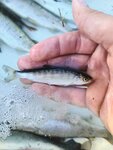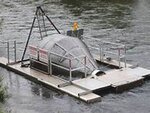



Compiled from a CTFW release by Michelle Compobasso
NESPELEM – Sub-yearling chinook salmon have been captured in the Sanpoil River above Grand Coulee Dam from adult chinooks that were planted in that Columbia River tributary in 2020.
A media release from PR spokeswoman Michelle Compobasso of the Colville Tribes Fish & Wildlife Department (CTFW) said the chinook fingerlings were captured in a rotary screw trap set near the mouth of the river by CTFW staff to monitor out-migrating Redband trout, a rainbow subspecies.
A rotary screw trap employs a large cone suspended between two floating pontoons. The action of the river water rotates the cone and detours a portion of the migrating fish into an underwater holding tank at the back of the trap.
“We operate the screw trap from May until November, and we’ve captured sub-yearling chinook on their way to Lake Roosevelt,” said Holly McLellan, principal CTFW biologist. “The first fish we captured was 93 millimeters long. We PIT tagged it and released it back into the river.”
The PIT tag Information System (PTAGIS) is a data collection and monitoring method that uses a small electronic radio transponder inserted into a fish to track its movements and behavior.
McLellan said the tagged fish will continue its migration downstream to the ocean. If it survives past Grand Coulee and Chief Joseph dams the tag will allow biologists to detect the surviving fish downstream. Neither Grand Coulee nor Chief Joe have PIT tag detecting arrays but the remaining major downstream dams so.
“We will continue to PIT tag all juvenile chinook greater than 65mm in length that we capture,” McLellan said.
Last August, 100 adult chinook were trapped at Wells Fish Hatchery, tested for pathogens, then transported by truck and released into the Sanpoil River, the CTFW media release said. Each fish was PIT tagged to track their movements. In October, staff walked the stream and counted 36 redds or egg nests that were within about six miles of the release sites. The work last fall confirmed that most of the salmon appeared to have stayed in the area, survived, and spawned.
“It is exciting that our fisheries department has identified 70 juveniles that were the result of our cultural releases of salmon in the Columbia and the Sanpoil Rivers,” said Chairman of the Colville Business Council Rodney Cawston. “With the construction of Chief Joseph and Grand Coulee dams, our people were separated from tradition and loss of salmon populations had a large impact on our people. Our people feel they have never intentionally relinquished their rights to the resources and fishing practices that historically have been a significant part of our lives.”
The Colville Confederated Tribes have been working closely with the Upper Columbia United Tribes and the Washington Department of Fish and Wildlife to pursue a phased approach to reintroducing salmon in the blocked areas upstream of Chief Joseph and Grand Coulee dams, said the CTFW media release. Phase 1 is complete and included science and feasibility evaluations. Phase 2 will include multiple studies to test feasibility and determine the best path forward to continue reintroduction efforts of moving salmon into the blocked areas.
Comments
No comments on this item Please log in to comment by clicking here